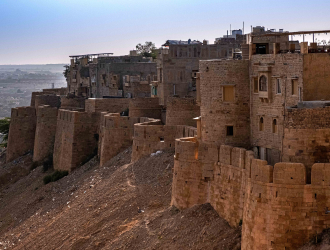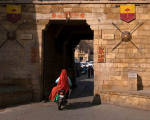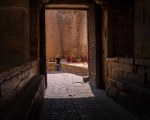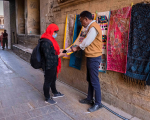The state Rajasthan invokes images of forts, dry landscapes, sand dunes, camel caravans, peacocks and spectacular royal palaces. All these elements come together at Jaisalmer, the largest district in Rajasthan. Established in 1156 CE by Bhati Rajputs, Jaisalmer was a princely state with a 15-gun salute status during the British Raj. Post Independence, it acceded to India, but the creation of Pakistan had a severe impact on its economy. The new international border severed Jaisalmer from the Silk Route trade networks, which connected it to Sindh, Punjab, Afghanistan and Balochistan, resulting in its main source of income, earned by levying taxes on caravans, drying up completely.
Jaisalmer was made a district under Jodhpur division but was relegated to a desert backwater. The 1965 India-Pakistan War brought the sleepy town into the limelight. The Indian military, both army and air force, made the town a base for operations. During the 1971 Bangladesh Liberation War, the famous Battle of Longewala was fought in the Thar Desert. However, though these events gave Jaisalmer new strategic importance, it did not bring revenue for its inhabitants. That happened due to the vision and effort of one man, and the story of Jaisalmer Fort is an example of how popular culture can play a role in reviving a forgotten site and secure its position in public memory.
In 1968, Satyajit Ray, noted Bengali film director, shot his fantasy adventure movie, Goopy Gyne Bagha Byne, at Jaisalmer. The climax of the story, in which several hundred extras and camels were needed to recreate a medieval war, was provided by the Jaisalmer royal family. On this first visit, Ray was deeply impressed by the hospitality, desert location and evocative architecture of Jaisalmer Fort. It was the genius of Ray that identified Jaisalmer as unique among Rajasthan’s innumerable forts because of its yellow colour, which was accentuated in the bright sunlight to a shade of golden hue. During the shooting of Goopy Gyne Bagha Byne, he was restrained by budget, thus had to shoot in black-and-white film. Feeling he had not done justice to the unique characteristic of Jaisalmer Fort, he decided to return for a second film dedicated to the fort as a central character.
He got his chance in 1973 when he returned to Jaisalmer to shoot Sonar Kella (Golden Fortress). Unlike his previous film, this time he had a higher budget and was able to shoot in colour. Sonar Kella was based on a story of his own writing about the exploits of fictional detective Feluda and his sidekick Topshe. From Kolkata, the duo trail Mukul, a five-year-old boy, who claimed to have lived in a ‘golden fortress’ and died in childhood during an attack on the fort, in a previous life. In the film, it is revealed that Mukul’s description of a golden fortress is not fantasy, but a factual clue based on recollection, of the yellow limestone used in making Jaisalmer Fort. However, unlike Mukul’s story, the story of the attack was a real event. In the 1290s, Jaisalmer Fort was laid siege by Alauddin Khilji’s army for eight long years, which ended in 1294 CE, with women and children committing jauhar (self-immolation), while the men rode out to face certain death in battle. This important event is still remembered by locals.
In the early 1970s, Jaisalmer Fort was in a state of dereliction and ruin. In Sonar Kella, Ray and his cameraman, Soumendu Roy, give a quick tour of the fort spaces, seen through Mukul’s recollections of the place. However, Ray omitted one crucial detail. He showed Jaisalmer Fort as an abandoned ghost town, which was not the case. The fort was always a ‘living fort’. The royal family had their palace inside the fort, and the palace employees lived within the protection of the fort walls. Only much later, in the eighteenth century, did the city start to spread outside the fort walls.
Sonar Kella released in 1974 to critical acclaim, winning the Golden Lotus Award at the National Film Awards in 1975 for Best Direction and Best Screenplay. It has since become a cult hit among Bengali audiences, particularly children. The film brought lasting fame not only to Satyajit Ray but also boosted the image of Rajasthan as a domestic tourism destination. Other than Jaisalmer, Sonar Kella also featured several other forts, those at Bikaner (Junagarh), Jodhpur (Mehrangarh), Jaipur (Nahargarh) and Delhi (Red Fort). Bengali tourists started visiting Jaisalmer from the mid-70s, long before the town had any tourism infrastructure. It has been almost 50 years since Sonar Kella was released, but there are no signs of its waning popularity among Bengalis, who still form a large percentage of domestic tourists visiting Jaisalmer each year, retracing the adventure of Feluda and Topshe.
However, though Ray helped boost tourism, Jaisalmer was not developed to cope with high tourist footfall. Unlike big cities like Jaipur, Jodhpur or Udaipur, there was no urban infrastructure. Most people living in the town depended on the patronage of the royal family to earn a living or were traders. In 1971, the Indian government abolished the Privy Purse of reigning rulers of erstwhile princely states. Like other royal families, the Jaisalmer royal family too was hit by a lack of maintenance funds for their properties. They vacated their palace inside the fort and converted it to a museum. The fort population had to diversify their professions to sustain. As tourism picked up, fort residents converted their homes to guest houses, shops, restaurants, cafes or offices from where they ran tour agencies.
In 1987, a big shift in Jaisalmer’s water resources happened when the 649-kilometre-long Indira Gandhi Canal—which delivers water from Punjab to Rajasthan—was made operational. Both the ecology of the Thar Desert and the lives of the people of Jaisalmer changed dramatically. Historically a drought-prone district, Jaisalmer could now be irrigated and residents of Jaisalmer fort had access to a year-round supply of water plumbed directly to their homes, replacing old methods of water harvesting and water collection. A rise in tourism also made it necessary to install Western-style toilets for Western tourists in guest houses, which consume far more water. An increase in water consumption caused water to seepage into the clay-rich soil under the fort, destabilising it and causing the collapse of its structures.
Jaisalmer Fort is built upon a sedimentary rock core of yellow limestone—the same stone used in the local architecture and fort walls. This raised plateau is elevated 250 feet above the surrounding landscape, retained within a defensive wall with 99 bastions, mori, slope and pitching. Buildings along the bastion wall discharge sewerage in an ad hoc manner onto the mori and slope. The introduction of modern plumbing has accelerated the rate of deterioration. In July 1999, two bastions and a large section of the pitching wall collapsed during unexpected heavy rainfall. Alarmed by the damage, World Monument Fund (WMF) put Jaisalmer Fort on its watch list in 1996, 1998 and 2000. In 2003, WMF and the Indian government, through the Archaeological Survey of India, signed a memorandum of understanding to prepare a conservation plan and conduct studies required to stabilise the fort. Today, the Rajasthan Urban Infrastructure Project, a joint Government of Rajasthan and Asia Development Bank project, is in process of upgrading the fort’s drainage systems.
The forts of Rajasthan have not only weathered centuries of erosion being exposed to the dry, hot climate but have also withstood numerous sieges by invaders. Yet they are still standing tall and strong, a symbol of Rajput pride and their glorious history. As the era of warfare ended, the forts lost their historical purpose of providing shelter during attacks, and they were depopulated, many converted to public spaces like museums or hotels. Jaisalmer is the last fort in Rajasthan still occupied by its original inhabitants. This unique factor was highlighted by UNESCO in 2013 by including Jaisalmer Fort as a World Heritage Site listed under ‘Hill Forts of Rajasthan’ (along with Chittorgarh Fort, Kumbhalgarh Fort, Ranthambore Fort, Gagron Fort and Amber Fort). This has brought great prestige to Jaisalmer, and this will hopefully bring greater awareness among tourists and fort residents about its uniqueness, something which Satyajit Ray had recognised half a century ago.
This content has been created as part of a project partnered with the Royal Rajasthan Foundation, the social impact arm of Rajasthan Royals, to document the cultural heritage of the state of Rajasthan.
















